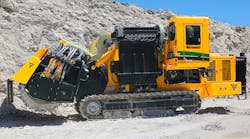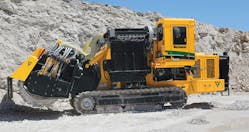This file type includes high resolution graphics and schematics when applicable.
Regulations continue to have a significant impact on productivity in the mining industry at a time when it’s already running on thin margins. Mine operators, therefore, look for a competitive advantage to help them increase production while also adhering to drill and blast regulations, addressing sound and vibration abatement, and reducing dust to minimize the effect on air quality.
Vermeer Corp., Pella, Ia., has come up with such an advantage with its T1255III Terrain Leveler surface excavation machine (SEM). The SEM features an optional dust suppression system, GPS steering, and grade control, as well as a cutting head attachment that can cut walls 80 deg. from horizontal.
This technology is ideal for use in surface mining—especially when faced with drill and blast restrictions or urban encroachment. One big advantage is its ability to produce smaller, more consistent particles than other machines. Doing so can eliminate the need for a primary crusher step.
Hydraulics at Work
The Terrain Leveler SEM features a patented tilt-head milling attachment with top-down cutting action that can dig up to 21 in. (53.3 cm) deep and 144 in. (365.8 cm) wide in a single pass—all with hydraulics. Hydraulic cylinders can tilt the drum ±5 deg. while a low-speed, high-torque hydraulic motor rotates the drum. As the unit travels forward with the drum rotating, the teeth on top of the drum advance over the top of the mineral surface. Operators can also control material sizing by increasing or decreasing the tooth penetration—again, by controlling the stroke of hydraulic cylinders. Uniform product size also allows for more efficient settings on secondary and tertiary crushing systems.
The direct-direct drive version of the machine has a fully hydrostatic motor mounted to the side of the cutting head to provide rotational power directly to the cutting drum. The end result is high efficiency and productivity when working in hard rock conditions. The direct-drive drum rotates at 18 to 26 rpm to cut an 80-deg. high wall, providing slope stability that is important in high-wall mining operations. When surfaces must be worked right up to the edge of a wall, Vermeer offers a twin chain-driven (each powered by a low-speed, high-torque motor) drum. This arrangement lets the quarry operator to cut a 90-deg. high wall and control drum speed from 25 to 36 rpm.
The T1255III is propelled and steered though a crawler drive with dual independent hydrostatic tracks boasting counter-rotation capability. This means the operator can quickly reposition the machine 180 deg. in either direction by simultaneously rotating one track forward and the other backward.
Operator Safety
The cab features an operator presence system that disengages the ground drive and cutting attachment if the operator leaves the seat. The machines are available with a rollover protective module (ROPM) and a falling object protective structure (FOPS) for working near a high pit wall. The machine’s low center of gravity helps maintain machine stability.
This file type includes high resolution graphics and schematics when applicable.




